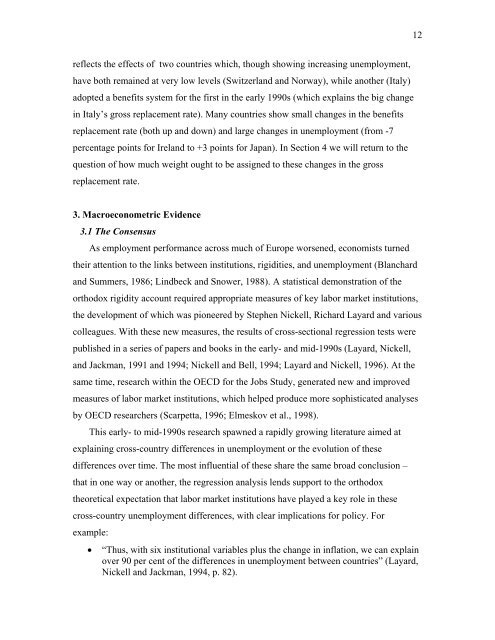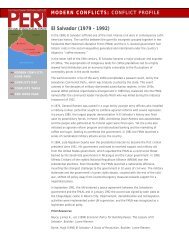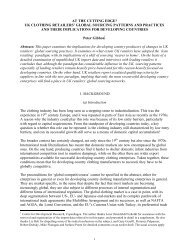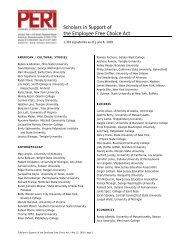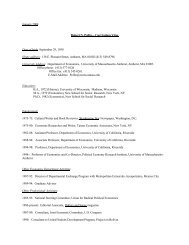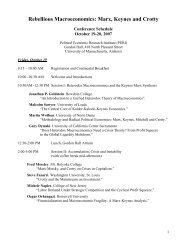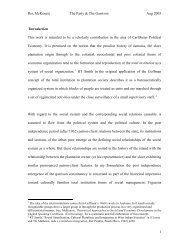Are Labor Market Institutions Really at the Root of Unemployment ...
Are Labor Market Institutions Really at the Root of Unemployment ...
Are Labor Market Institutions Really at the Root of Unemployment ...
You also want an ePaper? Increase the reach of your titles
YUMPU automatically turns print PDFs into web optimized ePapers that Google loves.
12<br />
reflects <strong>the</strong> effects <strong>of</strong> two countries which, though showing increasing unemployment,<br />
have both remained <strong>at</strong> very low levels (Switzerland and Norway), while ano<strong>the</strong>r (Italy)<br />
adopted a benefits system for <strong>the</strong> first in <strong>the</strong> early 1990s (which explains <strong>the</strong> big change<br />
in Italy’s gross replacement r<strong>at</strong>e). Many countries show small changes in <strong>the</strong> benefits<br />
replacement r<strong>at</strong>e (both up and down) and large changes in unemployment (from -7<br />
percentage points for Ireland to +3 points for Japan). In Section 4 we will return to <strong>the</strong><br />
question <strong>of</strong> how much weight ought to be assigned to <strong>the</strong>se changes in <strong>the</strong> gross<br />
replacement r<strong>at</strong>e.<br />
3. Macroeconometric Evidence<br />
3.1 The Consensus<br />
As employment performance across much <strong>of</strong> Europe worsened, economists turned<br />
<strong>the</strong>ir <strong>at</strong>tention to <strong>the</strong> links between institutions, rigidities, and unemployment (Blanchard<br />
and Summers, 1986; Lindbeck and Snower, 1988). A st<strong>at</strong>istical demonstr<strong>at</strong>ion <strong>of</strong> <strong>the</strong><br />
orthodox rigidity account required appropri<strong>at</strong>e measures <strong>of</strong> key labor market institutions,<br />
<strong>the</strong> development <strong>of</strong> which was pioneered by Stephen Nickell, Richard Layard and various<br />
colleagues. With <strong>the</strong>se new measures, <strong>the</strong> results <strong>of</strong> cross-sectional regression tests were<br />
published in a series <strong>of</strong> papers and books in <strong>the</strong> early- and mid-1990s (Layard, Nickell,<br />
and Jackman, 1991 and 1994; Nickell and Bell, 1994; Layard and Nickell, 1996). At <strong>the</strong><br />
same time, research within <strong>the</strong> OECD for <strong>the</strong> Jobs Study, gener<strong>at</strong>ed new and improved<br />
measures <strong>of</strong> labor market institutions, which helped produce more sophistic<strong>at</strong>ed analyses<br />
by OECD researchers (Scarpetta, 1996; Elmeskov et al., 1998).<br />
This early- to mid-1990s research spawned a rapidly growing liter<strong>at</strong>ure aimed <strong>at</strong><br />
explaining cross-country differences in unemployment or <strong>the</strong> evolution <strong>of</strong> <strong>the</strong>se<br />
differences over time. The most influential <strong>of</strong> <strong>the</strong>se share <strong>the</strong> same broad conclusion –<br />
th<strong>at</strong> in one way or ano<strong>the</strong>r, <strong>the</strong> regression analysis lends support to <strong>the</strong> orthodox<br />
<strong>the</strong>oretical expect<strong>at</strong>ion th<strong>at</strong> labor market institutions have played a key role in <strong>the</strong>se<br />
cross-country unemployment differences, with clear implic<strong>at</strong>ions for policy. For<br />
example:<br />
• “Thus, with six institutional variables plus <strong>the</strong> change in infl<strong>at</strong>ion, we can explain<br />
over 90 per cent <strong>of</strong> <strong>the</strong> differences in unemployment between countries” (Layard,<br />
Nickell and Jackman, 1994, p. 82).


